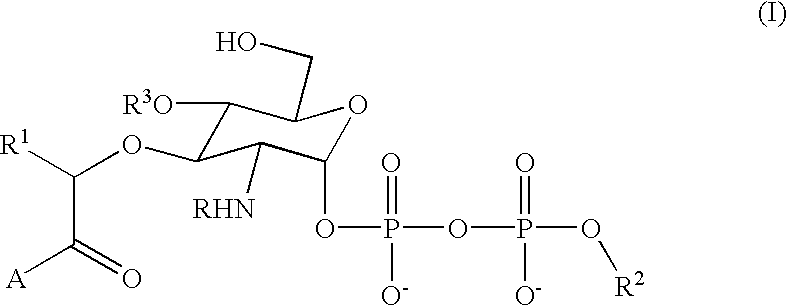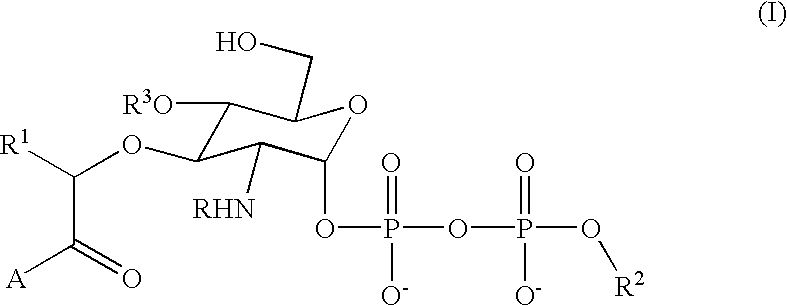Bacterial transglycosylases: assays for monitoring the activity using Lipid II substrate analogs and methods for discovering new antibiotics
a transglycosylase and substrate technology, applied in biochemistry apparatus and processes, instruments, peptides, etc., can solve the problems of intrinsically difficult to obtain lipid ii substrate in large quantities, exceedingly difficult to study downstream enzymes, and difficult to detect or measure coupling products, so as to facilitate the detection or measurement of coupling products.
- Summary
- Abstract
- Description
- Claims
- Application Information
AI Technical Summary
Benefits of technology
Problems solved by technology
Method used
Image
Examples
Embodiment Construction
5.1. General Aspects of the Invention
It should be evident to one of ordinary skill that the substance disclosed and described herein can also possess inhibitory activity against the transglycosylation activity of at least wild type transglycosylase enzyme, its homologs, recombinant or natural, and, possibly, certain mutant forms thereof, depending in part on the strength of its binding affinity with the protein or its active fragments. That is, a substrate analog of the present invention, by binding tenaciously to the protein or active fragment thereof, can potentially inhibit the ability of transglycosylase or a transglycosylase-like enzyme to catalyze the transglycosylation. Of course, transglycosylase and its homologs are derived from E. coli, H. influenzae and other gram-negative bacteria. Gram-positive bacteria, such as B. subtilis, E. faecalis, E. hirae, as well as M. tuberculosis, are also known to harbor homologs of transglycosylase.
5.2. The Transglycosylase Reaction
The tran...
PUM
| Property | Measurement | Unit |
|---|---|---|
| Composition | aaaaa | aaaaa |
| Solubility (mass) | aaaaa | aaaaa |
| Fluorescence | aaaaa | aaaaa |
Abstract
Description
Claims
Application Information
 Login to View More
Login to View More - R&D
- Intellectual Property
- Life Sciences
- Materials
- Tech Scout
- Unparalleled Data Quality
- Higher Quality Content
- 60% Fewer Hallucinations
Browse by: Latest US Patents, China's latest patents, Technical Efficacy Thesaurus, Application Domain, Technology Topic, Popular Technical Reports.
© 2025 PatSnap. All rights reserved.Legal|Privacy policy|Modern Slavery Act Transparency Statement|Sitemap|About US| Contact US: help@patsnap.com



